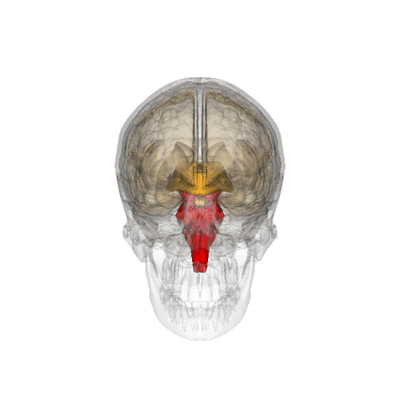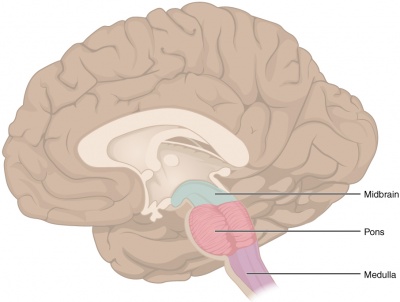Brainstem
Original Editor - Wendy Walker
Lead Editors - Lucinda hampton, Olajumoke Ogunleye, Pacifique Dusabeyezu, Evan Thomas, Wendy Walker, Kim Jackson, Garima Gedamkar, Aya Alhindi, WikiSysop, Tarina van der Stockt, Daniele Barilla and Carina Therese Magtibay
Description[edit | edit source]
The Brainstem lies at the base of the brain and the top of the spinal cord. Image: The 3 structures of the brainstem.
The brainstem is the structure that connects the cerebrum of the brain to the spinal cord and cerebellum.
- It is composed of 3 sections in descending order: the midbrain, pons, and medulla oblongata.
- It is responsible for many vital functions of life, such as breathing, consciousness, blood pressure, heart rate, and sleep.
The brainstem contains many critical collections of white and grey matter.
- The grey matter within the brainstem consists of nerve cell bodies and form many important brainstem nuclei. Ten of the twelve cranial nerves arise from their cranial nerve nuclei in the brainstem
- The white matter tracts of the brainstem include axons of nerves traversing their course to different structures; the axons originate from cell bodies located elsewhere within the central nervous system (CNS). Some of the white matter tract cell bodies are located within the brainstem as well. These tracts travel both to the brain (afferent) and from the brain (efferent) such as the somatosensory pathways and the corticospinal tracts, respectively.
Although it is the most evolutionarily ancient part of our brain, the brainstem is still very complex and important.
- The brainstem may not provide us with the higher intelligence we normally associate with being human, but it does carry all of the information to and from those areas we do associate with higher intelligence.
- It ensures the vital functions necessary to support those areas continue uninterrupted.[1]
Structure[edit | edit source]
The brainstem is generally said to be composed of three parts.
Components, from above downward:
- Midbrain (or Mesencephalon)
- Pons (part of the metencephalon)
- Medulla AKA Medulla Oblongata (myelencephalon)
Midbrain[edit | edit source]
The upper posterior (i.e. rear) portion of the midbrain is called the tectum, which means "roof." The surface of the tectum is covered with four bumps representing two paired structures: the superior and inferior colliculi. The superior colliculi are involved in eye movements and visual processing, while the inferior colliculi are involved in auditory processing.
At about the level of the superior colliculi, but located more anteriorly (i.e. toward the front) is another important nucleus called the substantia nigra. The substantia nigra, which literally means "black substance," was so named because it appears very dark in an unstained piece of tissue. The substantia nigra is rich in dopamine neurons and is considered part of the basal ganglia, which is a collection of nuclei that are crucial to normal motor movement. In patients who are suffering from Parkinson's disease, neurodegeneration occurs in the substantia nigra, and this neurodegeneration is associated with the hallmark movement dysfunction we see in Parkinson's.
Pons[edit | edit source]
The pons is an important pathway for tracts that run from the cerebrum down to the medulla and spinal cord, as well as for tracts that travel up into the brain. It also forms important connections with the cerebellum via fiber bundles known as the cerebellar peduncles.
The pons is home to a number of nuclei for cranial nerves. Nerves that carry information about sensations of touch, pain, and temperature from the face and head synapse in a nucleus in the pons. Motor commands dealing with eye movement, chewing, and facial expressions also originate in the pons. Additionally, cranial nerve nuclei in the pons are involved in a number of other functions, including swallowing, tear production, hearing, and maintaining balance/equilibrium.
Consists of a posterior part, the tegmentum, and an anterior basilar part.
Medulla[edit | edit source]
In addition to being the point where the brainstem connects to the spinal cord, the medulla contains a nucleus called the nucleus of the solitary tract that is crucial for our survival. The nucleus of the solitary tract receives information about blood flow, along with information about levels of oxygen and carbon dioxide in the blood, from the heart and major blood vessels. When this information suggests a discordance with bodily needs (e.g. blood pressure is too low), there are reflexive actions initiated in the nucleus of the solitary tract to bring things back to within the desired range.
Thus, the medulla is essential to our survival because it ensures vital systems like the cardiovascular and respiratory systems are working properly. Additionally, the medulla is responsible for a number of reflexive actions, including vomiting, swallowing, coughing, and sneezing. Several cranial nerves also exit the brainstem at the level of the medulla.
- The "bulb" is an archaic term for the medulla oblongata, and in modern clinical usage the word bulbar (e.g. bulbar palsy) is retained for terms that relate to the medulla oblongata. The word bulbar can refer to the nerves and tracts connected to the medulla, and also by association to the muscles thus innervated, such as those of the tongue, pharynx and larynx.[2]
Anatomical Relations[edit | edit source]
The brainstem is located in posterior cranial fossa[3].
Relations
- Above, the midbrain is continuous with the cerebral hemisphere.
- Below, the medulla is continuous with the spinal cord.
- Posteriorly, the pons and medulla are separated from the cerebellum by the fourth ventricle.
Function[edit | edit source]
The brainstem has three broad functions:
1. Serves as a conduit for the ascending tracts and descending tracts connecting the spinal cord to the different parts of the higher centres in the forebrain
2. Contains important reflex centres associated with the control of:
- respiration
- cardiovascular system
- consciousness
3. Contains the nuclei of Cranial Nerves III to XII.
The brain stem is responsible for, and regulatory of, the following functions of the human body:
- Alertness
- Attention
- Arousal
- Breathing
- Heart rate
- Blood pressure
- Conveys information and signals shared between the peripheral nerves and spinal cord to the upper brain
- Other autonomic functions such as digestion, salivation, perspiration, dilation or contraction of the pupils, urination, etc.
Clinical Significance[edit | edit source]
Significant clinical problems can affect the brainstem such as stroke, malignancy, demyelinating processes, and many more.
eg A Stroke affecting the brainstem can cause severe symptoms which include:
- Problems with vital functions, such as breathing - frequently resulting in death
- Difficulty using with chewing, swallowing, and speaking
- Weakness or paralysis in the arms, legs, and/or face
- Problems with balance or sensation
- Hearing loss
- Vision problems
- Vertigo
- Locked-in Syndrome
- Coma [4]
Important conditions that can affect the upper brainstem include: hemiballismus from damage to the subthalamic nucleus; injury to or degeneration of dopaminergic neurons in substantia nigra resulting in Parkinson’s disease.
Damage to the lower brainstem can result in many different syndromes including:
- Wallenberg stroke (spinothalamic tract, spinal trigeminal tract, hypothalamospinal tract, vestibular nuclei)
- Cerebellar tonsillar herniation (sudden respiratory and cardiac arrest due to compression of the medulla)
- Medial pontine syndrome (abducens nerve, corticospinal tract, medial lemniscus)
- Central pontine myelinolysis from the rapid correction of hyponatremia, which can result in seizures, ataxia, and disturbed consciousness.
The 9 minute video below gives a good summary of brainstem and stroke[5]
Brainstem lesions frequently occur in Multiple Sclerosis, with visual problems including blurred double vision being a common early symptom of MS.
Central pontine myelinolysis is a concentrated, frequently symmetric, noninflammatory demyelination within the pons.
References[edit | edit source]
- ↑ Neuroscientifically challenged Know your brainstem Available from:https://www.neuroscientificallychallenged.com/blog/know-your-brain-brainstem (accessed 9.1.2021)
- ↑ World Heritage Encyclopedia. Medulla Oblungata. http://www.ebooklibrary.org/Articles/Medulla%20oblongata?&Words=Medulla (accessed 8 april 2017)
- ↑ Nolte J. The Human Brain. 3rd. St. Louis, Missouri: Mosby Year Book; 1993
- ↑ Brain Injury Explanation. http://www.braininjury-explanation.com/consequences/impact-by-brain-area/brainstem (accessed 8 april 2017)
- ↑ Basinger H, Hogg JP. Neuroanatomy, Brainstem. StatPearls [Internet]. 2020 May 23 Available from:. https://www.ncbi.nlm.nih.gov/books/NBK544297/ (accessed 9.1.2021)
- ↑ Soton brain hub Brainstem Stroke Syndromes Available from: https://www.youtube.com/watch?v=qxiRfP9XmpE (last accessed 28.11.2019)








